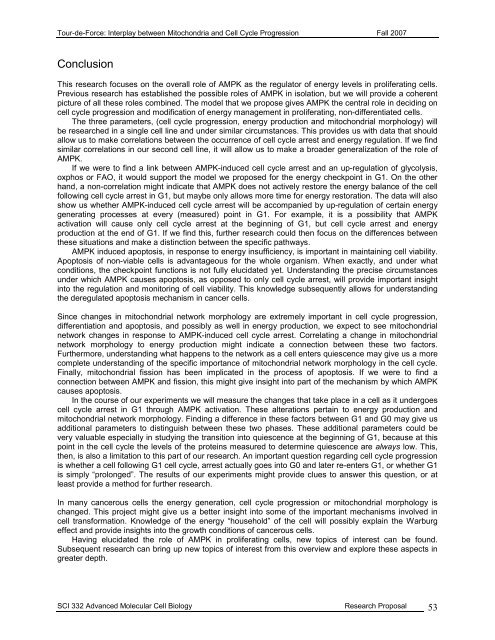Tour-de-Force
Tour-de-Force
Tour-de-Force
You also want an ePaper? Increase the reach of your titles
YUMPU automatically turns print PDFs into web optimized ePapers that Google loves.
<strong>Tour</strong>-<strong>de</strong>-<strong>Force</strong>: Interplay between Mitochondria and Cell Cycle Progression Fall 2007ConclusionThis research focuses on the overall role of AMPK as the regulator of energy levels in proliferating cells.Previous research has established the possible roles of AMPK in isolation, but we will provi<strong>de</strong> a coherentpicture of all these roles combined. The mo<strong>de</strong>l that we propose gives AMPK the central role in <strong>de</strong>ciding oncell cycle progression and modification of energy management in proliferating, non-differentiated cells.The three parameters, (cell cycle progression, energy production and mitochondrial morphology) willbe researched in a single cell line and un<strong>de</strong>r similar circumstances. This provi<strong>de</strong>s us with data that shouldallow us to make correlations between the occurrence of cell cycle arrest and energy regulation. If we findsimilar correlations in our second cell line, it will allow us to make a broa<strong>de</strong>r generalization of the role ofAMPK.If we were to find a link between AMPK-induced cell cycle arrest and an up-regulation of glycolysis,oxphos or FAO, it would support the mo<strong>de</strong>l we proposed for the energy checkpoint in G1. On the otherhand, a non-correlation might indicate that AMPK does not actively restore the energy balance of the cellfollowing cell cycle arrest in G1, but maybe only allows more time for energy restoration. The data will alsoshow us whether AMPK-induced cell cycle arrest will be accompanied by up-regulation of certain energygenerating processes at every (measured) point in G1. For example, it is a possibility that AMPKactivation will cause only cell cycle arrest at the beginning of G1, but cell cycle arrest and energyproduction at the end of G1. If we find this, further research could then focus on the differences betweenthese situations and make a distinction between the specific pathways.AMPK induced apoptosis, in response to energy insufficiency, is important in maintaining cell viability.Apoptosis of non-viable cells is advantageous for the whole organism. When exactly, and un<strong>de</strong>r whatconditions, the checkpoint functions is not fully elucidated yet. Un<strong>de</strong>rstanding the precise circumstancesun<strong>de</strong>r which AMPK causes apoptosis, as opposed to only cell cycle arrest, will provi<strong>de</strong> important insightinto the regulation and monitoring of cell viability. This knowledge subsequently allows for un<strong>de</strong>rstandingthe <strong>de</strong>regulated apoptosis mechanism in cancer cells.Since changes in mitochondrial network morphology are extremely important in cell cycle progression,differentiation and apoptosis, and possibly as well in energy production, we expect to see mitochondrialnetwork changes in response to AMPK-induced cell cycle arrest. Correlating a change in mitochondrialnetwork morphology to energy production might indicate a connection between these two factors.Furthermore, un<strong>de</strong>rstanding what happens to the network as a cell enters quiescence may give us a morecomplete un<strong>de</strong>rstanding of the specific importance of mitochondrial network morphology in the cell cycle.Finally, mitochondrial fission has been implicated in the process of apoptosis. If we were to find aconnection between AMPK and fission, this might give insight into part of the mechanism by which AMPKcauses apoptosis.In the course of our experiments we will measure the changes that take place in a cell as it un<strong>de</strong>rgoescell cycle arrest in G1 through AMPK activation. These alterations pertain to energy production andmitochondrial network morphology. Finding a difference in these factors between G1 and G0 may give usadditional parameters to distinguish between these two phases. These additional parameters could bevery valuable especially in studying the transition into quiescence at the beginning of G1, because at thispoint in the cell cycle the levels of the proteins measured to <strong>de</strong>termine quiescence are always low. This,then, is also a limitation to this part of our research. An important question regarding cell cycle progressionis whether a cell following G1 cell cycle, arrest actually goes into G0 and later re-enters G1, or whether G1is simply “prolonged”. The results of our experiments might provi<strong>de</strong> clues to answer this question, or atleast provi<strong>de</strong> a method for further research.In many cancerous cells the energy generation, cell cycle progression or mitochondrial morphology ischanged. This project might give us a better insight into some of the important mechanisms involved incell transformation. Knowledge of the energy “household” of the cell will possibly explain the Warburgeffect and provi<strong>de</strong> insights into the growth conditions of cancerous cells.Having elucidated the role of AMPK in proliferating cells, new topics of interest can be found.Subsequent research can bring up new topics of interest from this overview and explore these aspects ingreater <strong>de</strong>pth.SCI 332 Advanced Molecular Cell Biology Research Proposal 53
















